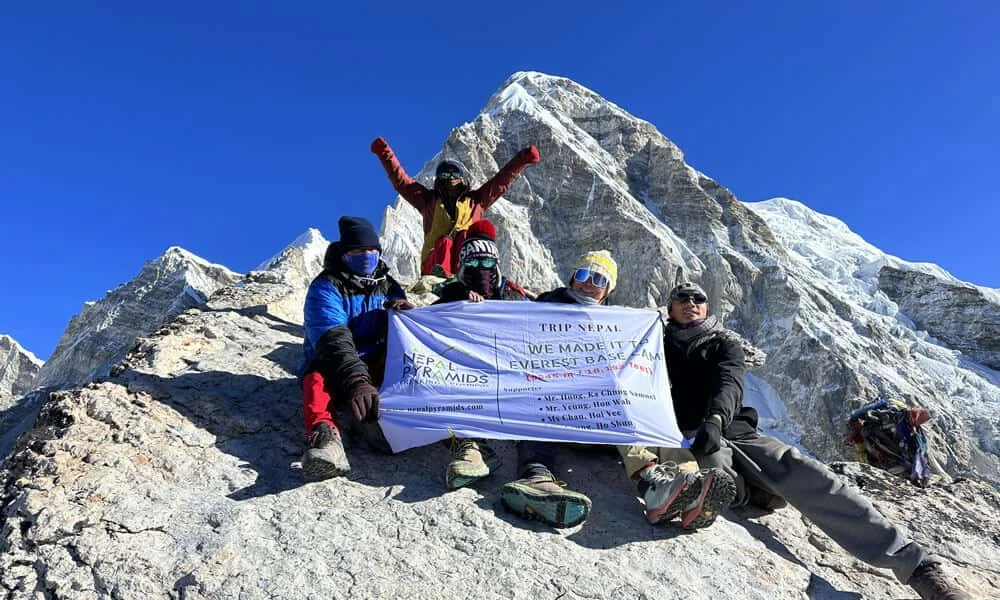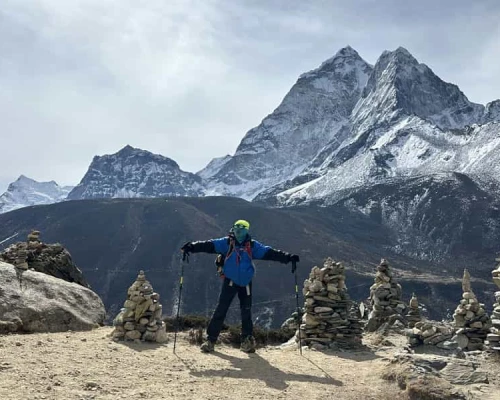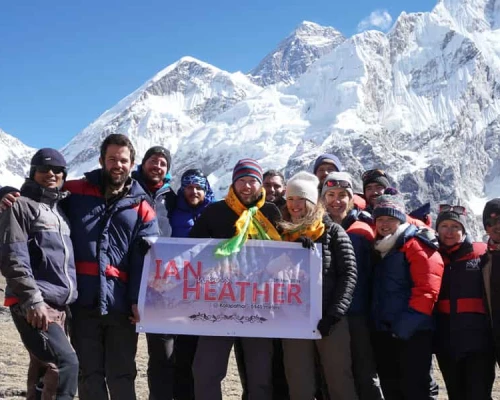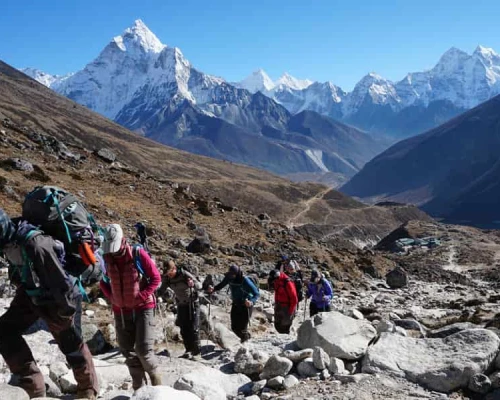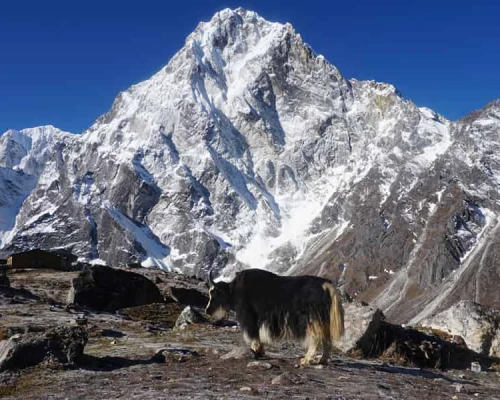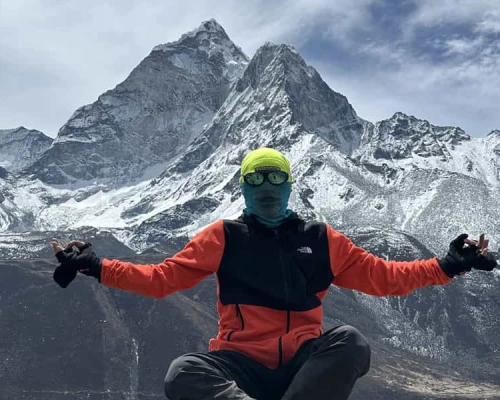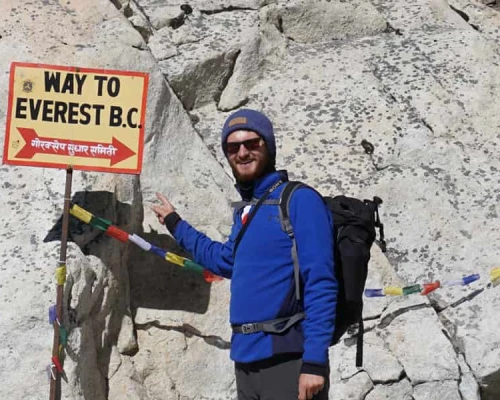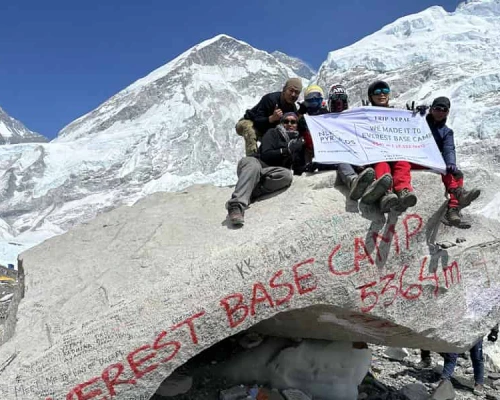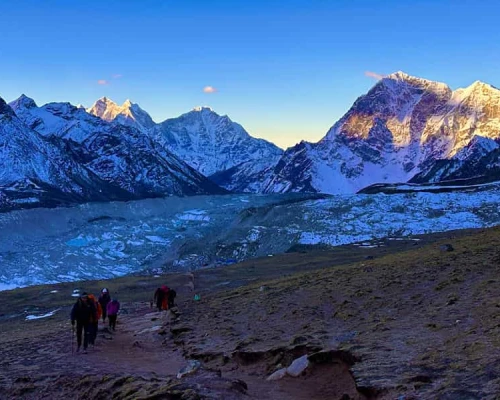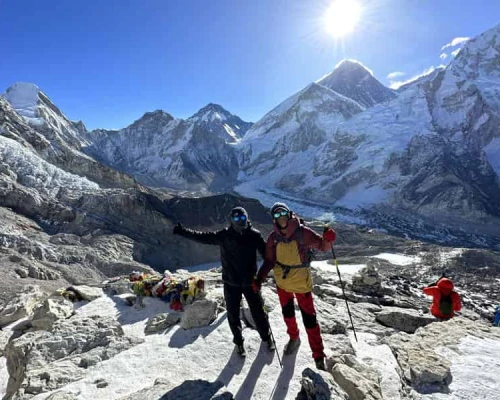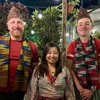Everest Base Camp Trekking Highlights:
- Arriving at the Capital City of Kathmandu, the living heritage of Nepal.
- Explore Thamel Bazaar where your hotel is located, this vibrant town echoes the bygone hippie era.
- A lifetime experience of landing at the world's thrilling Lukla Airport at the height of 2,840 meters.
- Walk the legendary trekking trail through the traditional Sherpa settlements.
- Cross the ICONIC HILLARY SUSPENSION BRIDGE.
- Rest day at Namche Bazaar, the capital of the Khumbu region.
- Overnight at the most picturesque village of Phortse with its terraced fields and breathtaking scenery.
- Close-up view of lofty mountains including iconic Ama Dablam, Thamserku, Everest, and their neighboring mountains.
- Witness the unique Sherpa lifestyle and their enchanting Tibetan-Buddhist culture.
- Trek through the high elevated trail with the view of Ama Dablam (the Matterhorn of Nepal) and the deep valleys.
- Stay at the best Sherpa village stops and create your memories.
- Stand with the sense of achievement at the Base of the world's highest mountain under the shadow of Mount Everest,
- Conque the highest point of EBC Trek, the Kala Patthar at 5,545 meters (18,192 feet).
- Thrilling takeoff from Lukla flight and enjoy the heavenly view on the way to Kathmandu.
Trip Overview:
Everest Base Camp Trekking is a once-in-a-lifetime opportunity that takes you to the most iconic and famous base camp in the world. The Everest Base Camp (EBC SOUTH FACE) is located in the Northeastern part of Nepal in the fascinating valley of Khumbu. It falls under the Sagarmatha National Park which was established in 1976. Because of its unique natural beauty and cultural significance Everest region was listed in the UNESCO World Heritage Site in the year 1979.
The coordinates for Everest Base Camp are approximately 28°0′26″N 86°51′34″E. This famous 16-day TEAHOUSE TREK to EBC is one of the most highlighted and acclaimed treks that takes you to the fascinating valley under the shadow of the world's highest peak. Furthermore, Everest Base Camp Trekking has bragged the title of "The Best Trekking Destination of The Year" several times.
Everest Base Camp Trekking is certainly an incredible adventure of a lifetime that will take you through the iconic route delivering the most picturesque view. This beautiful teahouse trek will take you to the land of the Sherpas and introduce you to the Tibetan Buddhist culture.
It offers you the opportunity to get close to the majestic mountains which is hard to find elsewhere. Every step takes you the the paradise-like valleys and the overall landscape setting is very dramatic. It is certainly an experience not found elsewhere. The trek takes you through various traditional Sherpa villages, offering insights into Sherpas' way of life, their culture, and their warm hospitality.
The legend states that the quest for Everest started a long time ago around the 1920s. This takes us back to the history of George Mallory and Andrew Irvine's expedition which is still very controversial.
However, the 1953 British Mount Everest Expedition under the leadership of John Hunt made a breakthrough. Among the team members, Edmund Hillary and Tenzing Norgay Sherpa successfully scaled the world's highest mountain. However, this would be the second human ascent to the elevation of 8000 meters after the successful human conquest of Annapurna in 1950 by Maurice Herzog and Louis Lachenal.
These breakthroughs undeniably unlocked the human quest and curiosity for mountain peaks and hidden valleys. Over time, these mountaineers lured so many travelers to follow in their footsteps to explore the Himalayan Kingdom. Now, every year thousands of trekkers and climbers from around the world come to visit these Himalayan Valleys to create their beautiful memories.
History of Everest:
During the British East India Company, a Great Trigonometrical Survey was conducted from India in 1856 by the British surveyors Sir George Everest and Andrew Waugh. It was during this mathematical calculation Everest was discovered as the world’s highest point. Across the Himalayan range, they calculated the height of this mountain as 29,002 feet from sea level and gave it the name PEAK XV (Peak 15). Later honoring the work of Sir George Everest the Peak XV was given the title 'EVEREST' and became the globally accepted name. It was only later the height of Mt. Everest was redefined to 29,029 feet and now it is 29,031 feet.
The history of Everest dates back to the early 20th century when the British mountaineers made the first attempt to climb Everest. In the year 1920, the British adventurers set on their mission, their very first mountaineering expedition to conquer this titanic peak.
Colonel Charles Howard-Bury led this mission-impossible journey including a team of seven climbers, one of whom was George Mallory. In the chronicles of mountaineering legends, Mallory's name would echo throughout history for his persistent attempts to scale this highest peak of the world.
The first-ever Everest Expedition is believed to have made it to a height of around 8,170 meters which is 26,800 feet. This was indeed the highest altitude record ever reached by humans at the time. It is said that the expedition team failed to summit and had to turn back. It was a failed expedition due to a few combinations of factors, including bad weather, unfamiliar terrain, and equipment failures.
Nevertheless, though they did not reach the summit, the expedition was certainly a great success in terms of their effort, the elevation they managed to get, as well as the knowledge gained about the route and high-altitude mountaineering.
The experience gained by the then-climbers proved to be valuable and helpful in their upcoming Everest Expeditions. Mallory returned to Everest in 1921 and 1924, the latter of which would be his final attempt. In the year 1924 George Mallory and Andrew Irvine attempted to climb the highest peak and become the first humans to reach its summit. Unfortunately, they disappeared while attempting to reach the summit. The historic mountaineering mystery of whether or not they reached the summit of Everest remains unsolved to this day.
In 1999 'The Mallory and Irvine Research Expedition' was conducted to find evidence if they made it to the summit of Everest. Still, mountaineers are trying to find some conclusive proof or any physical evidence to resolve this historic mountaineering mystery.
Eventually, the 1953 British Mount Everest Expedition led by John Hunt successfully achieved the long-standing national dream of the British. It was under John Hunt's leadership, on May 19. 1953, Sir Edmund Hillary and Tenzing Norgay became the first people to reach the summit of Mount Everest. They made history by conquering the highest point of the world which was a significant moment in mountaineering history and a moment of pride for the British.
They established their base camp at the foot of the Khumbu Icefall, which is now known as the southern base camp, on the Nepalese side of the mountain. Since then, the southern base camp has become the main starting point for climbers attempting to summit Mount Everest. This Everest Base Camp is now the most prominent trekking destination in the world.
Everest Base Camp Trek Route:
Our epic journey to Everest Base Camp Trekking begins with a scenic 4-hour, 132 km drive to Manthali Airport in the Ramechhap District. We board a small yet thrilling twin-otter plane, soaring high over the endless ridges and peaks of the Himalayas towards the legendary Lukla Airport. Lukla Airport is NOT a DANGEROUS airport in the world, in fact, it is one of the most exciting and thrilling airport in the world.
Upon landing in Lukla, we will take a break at the nearest guest house and enjoy hot tea. While our guys (porters) pack up the duffel bags you can witness the most spectacular view of flights landing and taking off in the lively Lukla airport. shortly after we will set off on foot, entering the Sagarmatha Buffer Zone which safeguards the ancient lands of the Sherpa people.
We spend our first night in Phakding, a colorful village of tea houses, prayer flags, and the stunning sight of Dudh Koshi Gorge. Continuing north, we enter the heartland of the Sherpas people, the local indigenous tribe who have lived for centuries in the region. Besides having a unique culture Sherpas have been world-class mountaineers with remarkable high-altitude skills.
Following the Dudh Koshi gorge and crossing ample suspension bridges including the iconic Hillary Suspension Bridge we get to Namche Bazaar. Namche Bazaar (3440 meters) is the administrative center and the busy capital of the Khumbu region. It is a lively vibrant town where we enjoy our last hot showers and ice-cold beers before the real adventure begins. Being at the height of 3440 meters we spend another day here as our acclimatization day.
After Namceh we will leave the well-trodden Everest Base Camp route behind and take the serene Gokyo Valley trail. After crossing the beautiful settlement of Mong-La, we will spend a night in Phortse. Phortse village is one of the most picturesque village in the region. It's a settlement with its traditional Sherpa architecture and ancient terraced farming fields set against the mighty Thamserku and Kangtega peaks.
Very few companies include this diverted itinerary which is indeed very peaceful and the view is magical. From Phortse we will take a high-elevated trail to get to Dingboche which is considered to be the most scenic trail in the region. From the village of Pangboche, we will join the regular EBC trail and trek towards our destination. Now leaving behind the tree-line zone we will enter into the alpine zone where the air is thin with only alpine herbs.
Dingboche is at a height of 4410 meters / 14,468 feet where we will spend another acclimatization day. After acclimatization day at Dingboche, once our bodies have adjusted to the altitude, we push further to the small settlement of Lobuche. Lobuche village is at a height of 4,940 m / 16,210 feet which is higher than Mont Blanc where we will sleep overnight.
After Lobuche, we will continue further on toward our ultimate goal – the iconic Everest Base Camp. In less than 3 hours we will get to the last settlement of Gorakshep at 5140 meters. We will have a quick lunch and head out for Everest Base Camp. After the successful ascent of EBC, we continue further to Kala Patthar at 5545 meters for sunset or sunrise views.
Having conquered the Kala Patthar summit, we descend to the village of Pheriche. Next, we will now take an alternative route back to civilization via the region's most sacred Buddhist sites – the centuries-old Tengboche monastery. It's a beautiful place with an exceptional view. We will visit this spiritual sanctuary where we complete our pilgrimage by lighting a butter lamp to give thanks for our safe passage.
From Tengboche, we descend through the rhododendron and head to Namche Bazaar to celebrate our achievements. Following the Dudh Kosi river valley, we retrace our steps back to Lukla and celebrate our final night with dancing, music, and gratitude with our amazing Sherpa guides and porters. They are the ones who made this extraordinary expedition possible. The next morning we will take another scenic flight back to the comforts and bright lights of Kathmandu – with incredible memories to last a lifetime.
Can kids do the Everest Base Camp Trek?
Yes, absolutely, Kids can do the Everest Base Camp Trek. Over the years we have witnessed some families considering taking their kids along with them for EBC Trek. We have certainly organized treks in Nepal including EBC with kids, however, it is a challenging journey. Let's explore the pros and cons of bringing kids on the Everest Base Camp Trek:
Pros:
- Children will surely have an unforgettable experience since EBC is considered a life-changing adventure.
- The trek will certainly add an educational value. It will offer a great learning experience about the Sherpa people, geography, Buddhism, and mountaineering history.
- Family bonding is one of the most significant things felt by the family groups while trekking in the Himalayas. Under the harsh weather, challenging terrains, and basicness, family relationships strengthen while lending support, care, and love.
- Children will develop resilience and perseverance as they gradually approach their destinations among the magical valleys. This progressively Improves their physical fitness and endurance.
Cons:
- The trek to Everest Base Camp is not easy, it is a strenuous adventure with significant elevation gain every day. A couple of hours hike daily under harsh weather circumstances can be challenging for kids. The parents must engage them in regular exercise before signing up for the EBC trek.
- It is believed that kids can be more vulnerable to altitude sickness than adults. Everest Base Camp trek gets to the height of 5545 meters / 18,192 feet (KALAPATTHAR) or 5360 meters / 17,585 feet which is Base Camp itself. So short days trek and enough acclimatization approach is very important.
- Safety concerns are fundamental when it comes to trekking with kids to EBC. Harsh weather, Physically demanding trials, dehydration, injuries, limitation on nutritious food, limited access to emergency services, isolated environment, etc may contribute to risk assessment. Choosing a professional guide and a local company is important.
- As you go higher, the basic accommodations and basic sanitation facilities may be uncomfortable for children.
- The trek expenses can be high in regards to employing more manpower to take care of kids, buying quality gear, extra rest days that would potentially extend the itinerary, insurance, etc.
- The standard itinerary for Everest Base Camp is 14 to 16 days, but with children to maintain a relaxed pace with shorter days may contribute to an 18 to 20-day itinerary.
Book Now for an Epic Everest Adventure!
Join our Everest Base Camp Trekking and let the tallest mountain in the world awaken your inner adventurer. Book your trip now to create lifelong memories in the heart of the Himalayas.
Each day presents new wonders - majestic panoramic peaks, winding trails, colorful prayer flags, cozy villages, unique culture, and dramatic landscapes. Reach the Everest Base Camp, stand at the BASE of the mightiest mountain on Earth, and feel a sense of accomplishment.
Don't wait - book your Everest adventure now with Nepal Pyramids Trekking and Climbing.
Check out Why Should You Do Everest Base Camp Trek?
People Also Search for:



